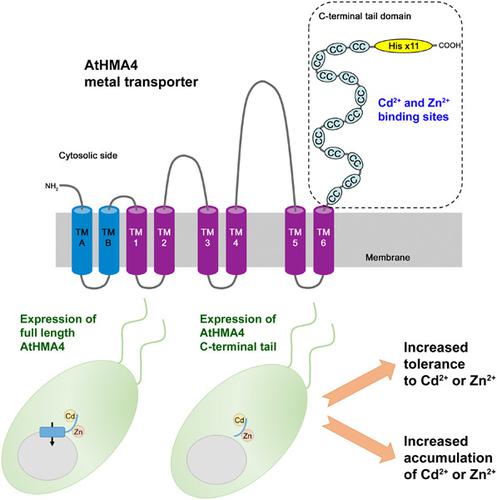当前位置:
X-MOL 学术
›
Biotechnol. Bioeng.
›
论文详情
Our official English website, www.x-mol.net, welcomes your feedback! (Note: you will need to create a separate account there.)
Increased metal tolerance and bioaccumulation of zinc and cadmium in Chlamydomonas reinhardtii expressing a AtHMA4 C-terminal domain protein.
Biotechnology and Bioengineering ( IF 3.8 ) Pub Date : 2020-06-24 , DOI: 10.1002/bit.27476 Aniefon Ibuot 1 , Rachel E Webster 2 , Lorraine E Williams 3 , Jon K Pittman 4
Biotechnology and Bioengineering ( IF 3.8 ) Pub Date : 2020-06-24 , DOI: 10.1002/bit.27476 Aniefon Ibuot 1 , Rachel E Webster 2 , Lorraine E Williams 3 , Jon K Pittman 4
Affiliation

|
The use of microalgal biomass for metal pollutant bioremediation might be improved by genetic engineering to modify the selectivity or capacity of metal biosorption. A plant cadmium (Cd) and zinc (Zn) transporter (AtHMA4) was used as a transgene to increase the ability of Chlamydomonas reinhardtii to tolerate 0.2 mM Cd and 0.3 mM Zn exposure. The transgenic cells showed increased accumulation and internalization of both metals compared to wild‐type. AtHMA4 was expressed either as the full‐length (FL) protein or just the C‐terminal (CT) tail, which is known to have metal‐binding sites. Similar Cd and Zn tolerance and accumulation was observed with expression of either the FL protein or CT domain, suggesting that enhanced metal tolerance was mainly due to increased metal binding rather than metal transport. The effectiveness of the transgenic cells was further examined by immobilization in calcium alginate to generate microalgal beads that could be added to a metal contaminated solution. Immobilization maintained metal tolerance, while AtHMA4‐expressing cells in alginate showed a concentration‐dependent increase in metal biosorption that was significantly greater than alginate beads composed of wild‐type cells. This demonstrates that expressing AtHMA4 FL or CT has great potential as a strategy for bioremediation using microalgal biomass.
中文翻译:

在表达 AtHMA4 C 端结构域蛋白的莱茵衣藻中增加金属耐受性和锌和镉的生物积累。
微藻生物质在金属污染物生物修复中的应用可能会通过基因工程来改善金属生物吸附的选择性或能力。植物镉 (Cd) 和锌 (Zn) 转运蛋白 (AtHMA4) 用作转基因以增加莱茵衣藻的能力耐受 0.2 mM Cd 和 0.3 mM Zn 暴露。与野生型相比,转基因细胞显示出两种金属的积累和内化增加。AtHMA4 表达为全长 (FL) 蛋白或仅 C 端 (CT) 尾,已知其具有金属结合位点。在 FL 蛋白或 CT 结构域的表达中观察到类似的 Cd 和 Zn 耐受性和积累,表明增强的金属耐受性主要是由于金属结合增加而不是金属运输。通过固定在海藻酸钙中以产生可添加到金属污染溶液中的微藻珠,进一步检验了转基因细胞的有效性。固定保持金属耐受性,而藻酸盐中表达 AtHMA4 的细胞显示出金属生物吸附的浓度依赖性增加,这显着高于由野生型细胞组成的藻酸盐珠。这表明表达 AtHMA4 FL 或 CT 作为使用微藻生物质进行生物修复的策略具有巨大潜力。
更新日期:2020-06-24
中文翻译:

在表达 AtHMA4 C 端结构域蛋白的莱茵衣藻中增加金属耐受性和锌和镉的生物积累。
微藻生物质在金属污染物生物修复中的应用可能会通过基因工程来改善金属生物吸附的选择性或能力。植物镉 (Cd) 和锌 (Zn) 转运蛋白 (AtHMA4) 用作转基因以增加莱茵衣藻的能力耐受 0.2 mM Cd 和 0.3 mM Zn 暴露。与野生型相比,转基因细胞显示出两种金属的积累和内化增加。AtHMA4 表达为全长 (FL) 蛋白或仅 C 端 (CT) 尾,已知其具有金属结合位点。在 FL 蛋白或 CT 结构域的表达中观察到类似的 Cd 和 Zn 耐受性和积累,表明增强的金属耐受性主要是由于金属结合增加而不是金属运输。通过固定在海藻酸钙中以产生可添加到金属污染溶液中的微藻珠,进一步检验了转基因细胞的有效性。固定保持金属耐受性,而藻酸盐中表达 AtHMA4 的细胞显示出金属生物吸附的浓度依赖性增加,这显着高于由野生型细胞组成的藻酸盐珠。这表明表达 AtHMA4 FL 或 CT 作为使用微藻生物质进行生物修复的策略具有巨大潜力。


























 京公网安备 11010802027423号
京公网安备 11010802027423号